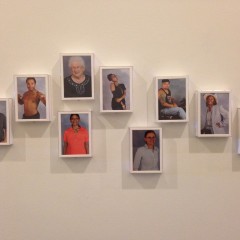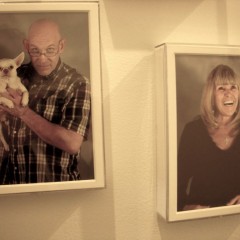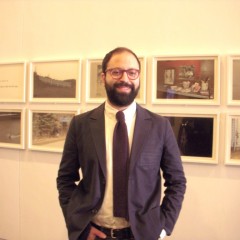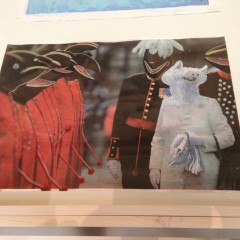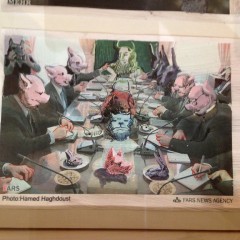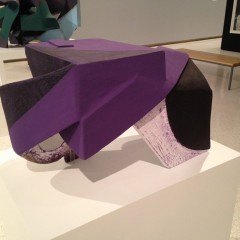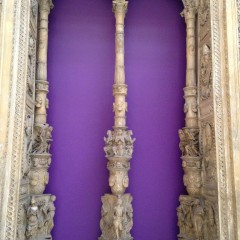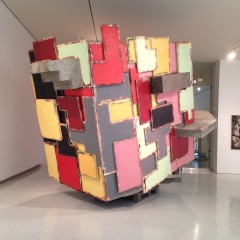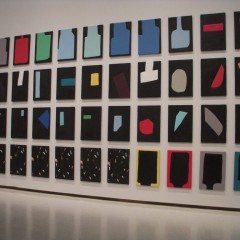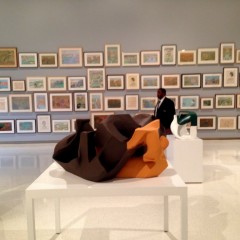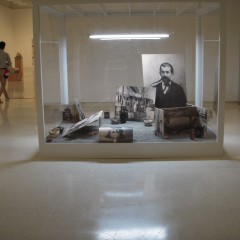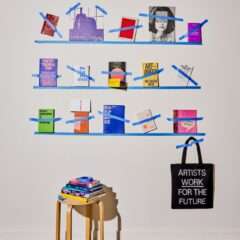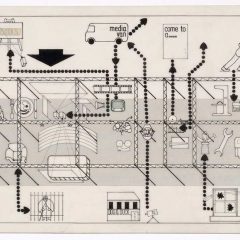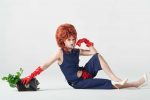While it doesn’t push the envelope or any obvious buttons, the 2013 Carnegie International serves up delights and high points along with the comfort and reassurance of familiar faces. It’s a humanist show that is mining territory that’s been mined before – history, community, anti-capitalism. And bravo for all that!
Community and Archival Projects
Many artists featured in the show are working with communities. Here are our favorites.
Let’s hear it for Zoe Strauss! She didn’t win the Carnegie Prize or the Fine Prize (those went to Nicole Eisenman and Zanele Muholi respectively — congrats to those two wonderful women artists!) but we love her Homesteading project, which is a piece commissioned by the museum. In addition to Strauss’s signature, gut-wrenching images of decaying urban space and portraits of people struggling with life in the former steel town of Homestead, Strauss’s portraits of ordinary folks from Homestead — installed like they are family pictures taken at K-Mart and hung in what seem to be South Philly row house portrait groupings — are terrific. We love this low-art, vernacular, from the people installation in the high art museum!
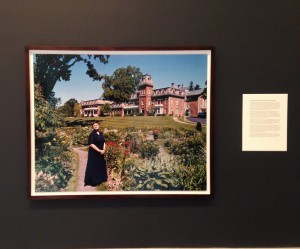
Joel Sternfeld’s beautiful and moody color photos of American visionaries who created and live in utopian communities give pause to any and all cliches about this country. The sheer number of utopian communities documented in these large photographs is telling. Many, may people are looking for solutions to many questions and problems.
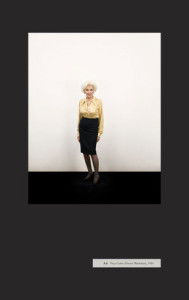
We like Taryn Simon’s archiving project, “Birds of the West Indies.” But the presentation — 190 small, dark, framed images on wall after wall after wall –beat us down at a certain point. This is a body of work that is perfect for a book. The subject of women, weapons and vehicles in the James Bond movies is a terrific subject, and the photos are wonderful and surprising. The women are pictured in mostly everyday clothes posed before a white background — hardly sexy or villainous — and the weapons and cars are shown as totally sexy, darkly-sensual objects. Give us a book, we say.
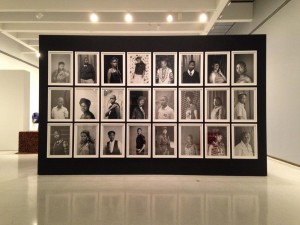
Zanele Muholi’s photos of the gay, lesbian, bisexual and transgender community in South Africa are deadly serious, activist, beautiful and haunting. We wonder why the photos are jammed into a grid on two sides of a modest, freestanding wall, like some kind of double-sided icon. We’ve seen Muholi’s works elsewhere, printed larger (we think) and hung eye-level around the gallery, which allows the full force of their presence to hit you. It’s a shame the photos are not allowed to surround you in a space. The way they are displayed here diminishes their cumulative impact.
Our Picks from the show
What you look for at a biennial, triennial or art fair depends on your orientation to the art world — buyer, curator, writer, artist, it makes a difference. What we get excited about is art we haven’t seen before or art that has a unique voice and energy — something that speaks beyond the art-insider bubble and straight to the heart.
Rokni Haerizadeh (Iran) is our pick for best of show. We like Haerizadeh’s human-bestiary commentary on the horrors of violence and on the folly of hierarchies. It’s a medieval approach to the reversion of the culture to medieval. Topical and eternal all at once, Haerizadeh’s troop transport vehicle is a yawning lion, maw stretched open to eat up the soldiers. Bird-headed villains beat up and eat up their enemy prey. Haerizadeh’s gorgeous handling of gouache over printed matter (newspaper photos of chaotic political street actions) creates a Hieronymus Boschian agitation. Animated animal imagery painted over video of the wedding of Kate Middleton to Wills into a sub-human comedy of vanities.
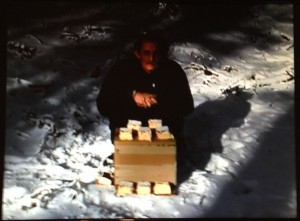
Bodies and politics mix with words in a mini-retrospective of the conceptual art of Croatian artist Mladen Stilinovic (b. Yugoslavia). He deserves the show-within-a-show treatment. Among our favorites is a beautiful video of himself selling potatoes in a quiet forest. If an artist sells potatoes or “potatoes” in a forest and no one looks, hears, or buys, is it still an anti-communist act? Does the video in the gallery overcome all that? Shades of Constructivism shine through in small paintings that criticize the social structure, as does an installation photos of ordinary people schlepping bags home from work.
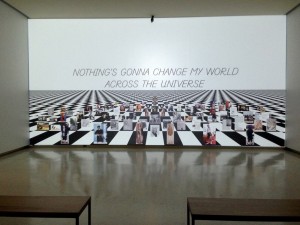
We are intrigued by Frances Stark’s hip-hop poetry-slam video installation with its celebrity chessboard and scrolling-billboard rant. The percussive urgency and the hint of a narrative are visceral. But a confusing and slippery mixed message leaves us wondering amidst the mish-mash of quotations, who was really speaking and if it was Frances Stark, just what is she saying? The taste we got gave us an interest in what comes next. And, give-away alert: Stark produced five broadsheet posters that continue her poetry slam into the world of paper and ink.
These three artists grapple with the daily realities of what it means to be human in social systems that are not always for the best, creating political art that transcends sloganeering and delves into what it means to be human.
Technology and Abstraction
One big question we have about the show: Where is the discussion of technology and human beings? If we have human concerns at all these days, many of them revolve around the tech world. Its intrusion into our lives (surveillance; NSA phone logs; Google reading your emails; social media enabling bullies;) is vast and problematic. And there are artists dealing with these issues. We would have loved to see Rafael Lozano-Hemmer or Liz Magic Laser, with some of their community-participatory projects in the mix. And how about bio-art? Eduardo Kac‘s mutant plants, and genetically-altered objects put issues of genetic modification and Big Pharma into the context of community.
Meanwhile, we want to say the inclusion of abstract art seems like palate cleanser in a show that doesn’t need one. The works by Sadie Benning, Vincent Fecteau and others, which we enjoyed seeing, harken to a strain of pure abstraction that doesn’t talk with the otherwise humanist show. Why not “humanist abstractionists” like Elizabeth Murray? Chris Martin? Thomas Nozkowski? We read that the museum world is revisiting abstract art for its thematic content. OK, great, but this show didn’t need to do that, or could have picked other artists to illustrate. We kind of don’t get it.
The Comfort Zone
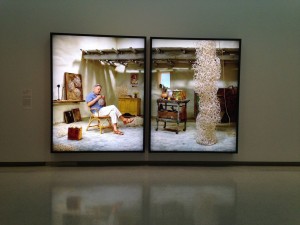
Rodney Graham, whose Canada-dry sense of humor we never tire of, doesn’t jibe with the heartfelt, earnest tone of the show.
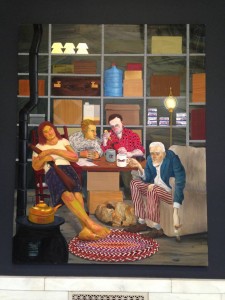
Nicole Eisenman, who we also love, disappointed us with her glib, art-history-referencing works and especially her Tea Party picture whose politics are too obvious and lack heat (a little Peter Saul heat might help).
We love self-taught and outsider artists and it is amazing to see Joseph Yoakum and George Ohr embraced by this big, important international art show–we say yay for that! The works’ inclusion reminds us that many artists toil outside the established systems of what is acceptable, marketable, desirable art. And that in time, the good stuff rises and, with advocacy and a little luck, gets its day in the sun.
The Opening
We hunted at the opening gala for Cindy Sherman. People told us she was there. “She’s wearing a blue dress,” someone said. “She’s wearing blue shoes,” someone else said. We never saw the elusive Sherman. But we were happy to see a goodly number of Philly folks — Zoe Strauss, Lynn Bloom and Zoe’s assistant, Grace Ambrose, were bubbling with excitement about Zoe’s Homesteading project. We saw Adelina Vlas, Assistant Curator of Contemporary Art at the Philly Museum of Art, looking radiant (she had just gotten married!), and a crew from the ICA, including Kate Kracson, Amie Sadao and Alex Klein. And while she’s not a Philly person, we were happy to run into Sylvie Fortin, who told us she is organizing the Montreal Biennial!
John Ollman, Alex Baker and Claire Iltis from Fleisher-Ollman Gallery were there — they had rounded up the Joseph Yoakum works for the show, including works collected by the founder of the Museum of Everything, James Brett, who we got to meet. Ollman told us that Yoakum’s presence in the International was a break-through for self-taught artists. It is the first time a self-taught artist’s works have appeared in a major international exhibition. All we can say is that this official seal of approval by museum-land caps a remarkable rise in the last couple years of outsider art, which is now embraced in the mainstream.
Meanwhile, we must pass judgment on the food at the party: Breaded and deep-fried macaroni and cheese nuggets and pigs-in-blankets are not for all members of the community. Fail. An addition of nuts and fruit would have done it for us. We are trying to deconstruct the message, and will get back to you when we do.
So, go see this good, worthy show! Support our cousins in Pittsburgh, who are totally into community and made a wonderful International. More pictures here and here.
The 2013 Carnegie International, through March 16, 2014. Carnegie Museum of Art, 4400 Forbes Ave, Pittsburgh, PA 15213. www.carnegieinternational.org


